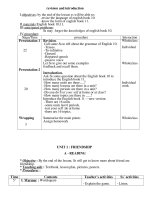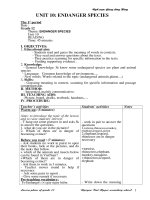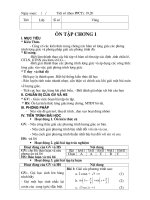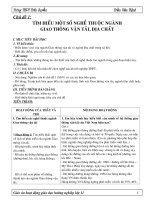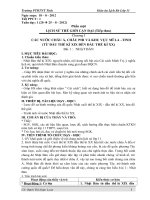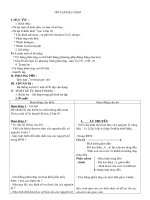giáo án anh lớp 11- unit 11
Bạn đang xem bản rút gọn của tài liệu. Xem và tải ngay bản đầy đủ của tài liệu tại đây (181.2 KB, 21 trang )
DATE: Jan 24
th
2013
PERIOD 68: UNIT 11: SOURCES OF ENERGY
LESSON 1: READING
I. OBJECTIVES
- By the end of the lesson, Ss will be able to skim for the gist of the text, scan for
specific information and express their own ideas about sources of energy.
- Practise reading skills such as reading for gist and for specific information
II. METHOD: Integrated, mainly communicative
III. TEACHING AIDS: Textbook, CD player, projector
IV. PROCEDURE
1. Organization (1minute)
Class Date Attendance Absentees
11 C
2. Oral check
- Check during the lesson
3. New lesson
Stages Teacher’s activities Students’ activities
Warm-up
(5’)
Pre-
reading (9’)
* Network
Oil coal
natural gas
Nuclear solar wind water
- What sources of energy do you
know?
- Look at the pictures of sources of
energy on page 124 and name
them?
1. Pre-teach vocab
- Fossil fuels (n): nhiên liệu hóa
thạch
- alternative (a): nhiên liệu thay
thế
- be exhausted (v) = run out: cạn
kiệt
- Some Ss write their
answers on the board.
Expected answers:
Wind turbine → wind
power
Solar pane → solar
energy
dam → water
power
(hydroelectric power)
- Eliciting some new words
from Ss
- Practise reading and copy
down
Sources of
energy
While-
reading
(18’)
Post -
reading
(10’)
– nuclear energy (n): năng lượng
nguyên tử
– release (v): thải
- infinite = endless (unlimited)
(a): vô tận
- make full use of (v): tận dụng
* Checking : rub out and
remember
Ask Ss to skim over the text then
do the tasks that follow.
1. Task 1. Gap-filling
- Ask Ss to fill in each blank with
a suitable word in the box.
- Ask Ss to refer to the text for the
difficult words
- Teacher and Ss check
2. Task 2.
- Get Ss to scan the passage and
write down the advantages and
disadvantages of each alternative
source of energy.
- Ask Ss to compare the answers
with their partners.
- Call on some Ss to say out the
answers
- T checks with the whole class.
3. Task 3. Answer the questions.
Get Ss to answer the questions.
- Ask Ss to compare the answers
with their partners.
- Call on some Ss to write the
answers on the board.
- T checks with the whole class.
- Ss work individually, and
then compare with a
partner.
- Some Ss say out their
answers
Expected answers :
1. released
2. alternative
3. energy
4. limited
5. exhausted
- Work individually, and
then compare with a
partner.
- Say out their answers
- Compare the answers with
their partners.
- Write the answers on the
board.
- Ss work individually, and
then compare with a
partner.
Expected answers :
1. It comes from fossil fuels
2. Five sources are
- Complete the summary of the
reading passage by filling each
blank with a suitable word from
the box.
- Give feedback and make
comments.
mentioned in the text.
I think solar energy is the
most potential.
- Work individually
- Compare the answer with
their partners
(1) energy; (2) one
(3) fuels; (4) limited
(5) alternative; (6) sources;
(7) unlimited)
(8) environment
4. Consolidation (1 minute)
- Remind main points of the lesson
5. Homework (1 minute)
- Learn new words, prepare for new lesson
DATE; Jan 24
th
2013
PERIOD 69: UNIT 11: SOURCES OF ENERGGY
LESSON 2: SPEAKING
I. OBJECTIVES
- By the end of the lesson, Ss will be able
+ to talk about endangered nature
+ express their own ideas about measures for protecting endangered nature
+ practise speaking skills
II. METHOD: Integrated, mainly communicative
III. TEACHING AIDS: Textbook
IV. PROCEDURE
1. Organization (1 minute)
Class Date Attendance Absentees
11 C
2. Oral check (6 minutes)
- Answer questions about the previous reading passage
3. New lesson
Stages Teacher’s activities Students’ activities
Warm-up
(4’)
Pre-
speaking
(6’)
Game : Jumbled words
- Give out a list of jumbled words (on a
poster)
- Ask Ss to find out the right words and
write on the board.
lutionpol – adgevanta – haustedex –
edunlimit – soudanger – gyener ralso
Answer key :
pollution – advantage – exhausted –
unlimited – dangerous – energy solar
Pre-teach vocab
- radiation (n); sự bức xạ
- abundant (a): phong phú
- renewable (a): có thể làm mới
- solar panel (n): hệ mặt trời
- By turns, representative
of each group writes a
right letter on the board.
- The group with more
right letters will win
- Eliciting from Ss
- Practise reading and
copy down
- Rewrite English words
- Say out their ideas
W hile-
speaking :
(18’)
Post-
speaking.
(8’)
- nuclear reactor (n): lò phản ứng
* Checking : rub out and remember
1. Task 1. Work in pairs.
- Write the words “advantages,
disadvantages” on the board.
- Ask Ss to read and say out A or D
- T writes on the board.
- Move around to give help
2. Task 2. Work in pairs
- Ask Ss to talk with a partner about the
advantages and disadvantages of using
each alternative source of energy, using
the suggestions from
Task 1
- Ask Ss to read the example
- Ask Ss some questions to check
whether they understand it or not
- Do a sample with a student in the
class
- Model conversation:
T: I think that water power can be an
alternative source of energy
S: Why do you think so?
T: Because our major source of energy
are running out while the water is
available and unlimmitted
S: I know it also provides energy
without pollution. However it is
expensive to build a dam for
hydroelectricity
Task 3. Work in groups
- Guide Ss how to do
- Ask Ss to work in groups to express
the belief on the increasing use of
alternative sources of energy in the
future
Expected answers:
1. D 2. D 3. D 4. A 5.
D 6. A
7. D
- Read the example
- Answer teacher’s
questions
- Do sample with the
teacher
- Listen to the
conversation
- Ss work in pairs to
substitute the underlined
words with suitable
words suggested in the
Useful language to make
a new conversations.
- Some pairs demonstrate
in front of the class.
- Listen to the teacher
- Work in groups to talk
about the increasing use
of alternative sources in
the future
- Do a sample in front of the class
Suggested answer:
I think that solar will be an effective
source of energy in the future because it
is not only plentiful and unlimited but
also clean and safe. Moreover, it is very
useful for our daily life
- Listen to teacher’s
4. Consolidation (1 minute)
- Remind main points of the lesson
5. Home work (1 minute)
- Review old lesson and prepare for the next one
DATE: Jan 25
th
2013
PERIOD 70: UNIT 11: SOURCES OF ENERGY
LESSON 3: LISTENING
I. OBJECTIVES
- By the end of the lesson, Ss will be able to
+ know more about how to protect environment
+ listen for general information and.
+ practise listening skill such as listening for specific information through multiple
choice questions and filling in the missing words
II. METHOD: Integrated, mainly communicative
III. TEACHING AIDS: Textbook, CD, cassette
IV. PROCEDURE
1. Organization (1 minute)
Class Date Attendance Absentees
11 C
2. Oral check (5 minutes)
- Talk about the advantages and disadvantages of using alternative energy
3. New lesson
Stages Teacher’s activities Students’ activities
Warm-up
(6’)
Pre-
listening
(6’)
W hile-
listening :
(17’)
Game : Word storm
- Divide the class into 4
groups.
- Tell Ss to list the things they
use energy for in their house.
- Ask representatives of the
groups write on the board.
- The group with more right
words will win.
Pre-teach vocabulary:
- ecology (n): sinh thái học
– replace (v): thay thế
– careful with (a): cẩn thận
với
– atmosphere (n): không khí
* Checking : What and where
* Listen and repeat
Today you’re going to listen
to a text about ecology. Listen
and do the tasks that follow.
1. Task 1 :
- Play the CD 2 times and
gets Ss to work in pairs to
choose the best answer
- Invite some Ss to give the
answers.
- Check the answers with the
whole class.
- Play the CD one more time
for Ss to listen and check if
necessary.
2. Task 2. Listen again and
write in the missing words
- Have Ss compare the results
Ss are divided into 4 groups.
Each group tries to write as many
things they use energy for as
possible:
Gas cooker – fridge – washing
machine – fan – light – TV ………
- Representatives of the groups
write on the board.
- Elicit new words from Ss
- Practise reading and copy down
- Some Ss rewrite the English
words.
- Ss work in pairs to guess the
options
- Some Ss make prediction and T
writes their predictions on the
board.
- Ss listen and check their
prediction.
- Ss listen for the second time
- Some Ss call out their answers
and T writes them on the board.
Expected answers :
1. D 2. C 3. D 4. A
5. C
- Ss work individually and then
compare the results with a partner.
Post-
listening.
(8’)
with a partner.
- Call on some Ss to write
their answers on the board.
- T and Ss check
Table completion
- Ask Ss to decide whether
the energy is renewable or
non-renewable. Put a tick in
the suitable column.
- Call some Ss to read their
ideas and check with the
class.
- Give feedback.
- Expected answer:
(1) unlimited
(2) atmosphere
(3) may
(4) gases
(5) amount
- Ss work individually, and then
compare with a partner.
Natural
resources
Non-
renewa
ble
Renew
able
Coal
Geotherma
l heat
Petroleum
Solar
energy
Oil
Wind
energy
Gas
4. Consolidation (1 minute)
- Remind main points of the lesson
5. Home work (1 minute)
- Learn old lesson and prepare for Chua bai kiem tra 1 tiet
DATE: Jan 25
th
2013
PERIOD : 71 UNIT 11: SOURCES OF ENERGY
LESSON 4: WRITING
I. OBJECTIVES
- By the end of the lesson, Ss will be able to read the information from a chart
+ write a description from a chart.
+ practise skills of writing to describe a chart
II. METHOD: Integrated, mainly communicative
III. TEACHING AIDS: Textbook
IV. PROCEDURE
1. Organization (1minute)
Class Date Attendance Absentees
11C
2. Oral check (5 minutes)
- Answer teacher’s questions about the previous listening passage
3. New lesson
Stages Teacher’s activities Students’ activities
Warm-up
(4’)
Pre-writing
(5’)
Game : What and Where
(about some words in the
previous lesson)
- Ask Ss to listen and repeat
those words and erase them word
by word.
Pre-teach Vocab:
- consume (v): tiêu thụ
– highland (n): cao nguyên
– trend (n): xu thế
– make up = account for (v):
cấu tao
- Eliciting from Ss
- Ss listen and repeat those words
- Some Ss go to the board and
rewrite the erased words.
- Eliciting from Ss
- Some Ss rewrite the English
words.
- Ss practise reading in chorus and
individually.
- Some Ss rewrite the English
W hile-
writing :
(20’)
– figure (n): hình ảnh
* Checking : rub out and
remember
1. Task 1 : Work with a
partner
- Ask Ss to study the chart about
energy consumption in Highland
in 2000 and fill in the gaps with
the information from the chart
- Go around the class and give
help when needed.
- Ask some Ss to write the letter
on a sheet of paper.
- T corrects Ss’mistakes if
needed
Expected answer:
1. 117
2. coal
3. smallest
2. Task 2
- Ask Ss to continue the
description of the trends in
energy consumption in the year
2005 in Highland using the facts
and figures suggested.
3. Task 3
- Ask Ss to describe the chart,
using information from Task 1
words.
- Some Ss answer the questions
1. What is the title of the chart?
2. How many sources of energy
are there in the chart? What are
they?
3. What made up the largest
amount?How many tons?
4. What made up the smallest
amount? How many tons?
- Ss work individually.
- Some Ss copy their writing on
the board.
- Other Ss give comments.
Sample writing for Task 2:
In 2005 the total energy
consumption was 170 million tons.
Nuclear and Hydroelectric made
up the largest amount of this
figure (75 million tons). This was
followed by the consumption of
petroleum (50 million tons). Coal
made up the smallest amount of
energy consumption (45 million
tons)
- Write their description on the
board
Sample writing for Task 3
The chart shows the energy
Post-
writing (8’)
and Task 2
- Guide Ss the ways to describe:
+ verb tenses: present tenses and
past tenses
+ words to describe chart: show,
increase, decrease, go up, rise,
fall, drop, slightly, sharply,
quickly, ….
- Ask Ss to work in pairs to
describe the chart
- Ask Ss to write their
description on the board.
- Get Ss to make peer corrections
T corrects Ss’mistakes if
needed
consumption in 2000 and 2005. As
can be seen, the total energy
consumption increased from 117
million tons in 2000 to 170 million
tons in 2005. Among three kinds
of sources, the consumption of
Nuclear and Hydroelectricity
rose sharply from 20 million tons
in 2000 to 75 million tons in 2005.
This was followed by coal which
went up slightly from 40 million
tons to 45 million tons. However,
the consumption of petroleum fell
from 57 million tons (2000) down
to 50 million tons ( in 2005).
……………
4. Consolidation (1 minute)
- Remind main points of the lesson
5. Home work (1 minute)
- Review old lesson and prepare for Unit 11, Language focus (1
st
)
DATE: February 15
th
2013
PERIOD 72: UNIT 11: SOURCES OF ENERGY
LESSON 5: LANGUAGE FOCUS (1
st
)
I. OBJECTIVES
- By the end of the lesson, Ss will be able to
+ distinguish the sounds / ∫r/ - / spl / - / spr /
+ understand the use of Relative clauses replaced by participles
II. METHOD: Integrated, mainly communicative
III. TEACHING AIDS: Textbook, cassette, CD
IV. PROCEDURE
1. Organization(1 minute)
Class Date Attendance Absentees
11C
2. Oral check
- Check during the lesson
3. New Lesson
Stages Teacher’s activities Students’ activities
Warm-up
(4’):
Pronunciati
on (7’)
Grammar
Game : Finding words
- Divide the class into two groups
and ask Ss to close their books.
- Ask each group to write on the
board:
+ 4 words containing the sound /∫r /
like shrimp
+ 4 words containing the sound /spl/
like split
+ 4 words containing the sound /spr/
like spring
- In two minutes, the group who
first finishes will wins
* Listen and repeat (p.121)
-Models the 4 clusters / ∫r / - / spl /
- / spr / a few times and explains
how to produce them.
- Ask Ss to read the words in each
column out loud in chorus for a few
times. Then call on some Ss to read
the words out loud.
* Practise reading these sentences
(p. 131)
1. Theory
relative clauses replaced by
participles
- write some sentences on the board a
- Some Ss say and write on
the board.
- Listen and repeat many
times in chorus and then
individually
- Listen and repeat after the
teacher
- Practise reading aloud the
sentences given on page
131.
- Practise in open pairs and
then in closed pairs.
- Ss work individually and
then compare with a
partner.
and
vocabulary
(30’)
+ The man who spoke to John is my
brother
The man speaking to John is my
brother
+ The sport games, which were held in
India in 1851, were the first Asian
Games
- The sport games held in India in 1851
were the first Asian Games
-Ask students to comment on the use of
relative clauses replaced by
participles
Active Ving phrase
Passive Ved/Vpp phrase
-Help students to use of them
-Ask some students give some similar
examples
2. Exercises
Exercise 1
Ask Ss to rewrite the following
sentences, using a present
participial phrase.
- Guide Ss how to do the exercise
Exercise 2
- Ask Ss to rewrite the sentences in
exercise 2, using past participial
phrase.
- Ask Ss to work in pairs
- Guide them how to do the exercise
* Expected answers :
1. The boy playing the
piano is my brother.
2. Do you know the
woman coming toward us?
3. The people waiting for
the bus in the rain are
getting wet.
4. The scientist researching
the causes of cancer are
making progress
5. The fence surrounding
our house is made of wood.
6. We have an apartment
overlooking the park.
* Expected answers :
1. The idea presented …
2. I come from a city
located in …
3. They live in a house
built in 1890.
4. The photographs
published …
5. The experiment
conducted …
- Do individually and
compare with a partner.
- Some Ss write the
answers on the board / read
aloud
4. Consolidation (2 minutes)
- Remind main points of the lesson
5. Homework (1 minute)
- Review old lesson and prepare for Unit 11, Language focus ( 2
nd
)
DATE: February 16
th
2013
PERIOD 73: UNIT 11: SOURCES OF ENERGY
LESSON 6 LANGUAGE FOCUS (2
nd
)
I. OBJECTIVES
- By the end of the lesson, Ss will be able to
+ understand the use of Relative clauses replaced by to infinitives
+ practise further with reduced relative clauses
II. METHOD: Integrated, mainly communicative
III. TEACHING AIDS: Textbook, paper test, hand-outs
IV. PROCEDURE
1. Organization(1 minute)
Class Date Attendance Absentees
11C
2. Oral check (12 minutes)
- mini written test
I. Choose the word or phrase ( A, B, C or D) that best completes each sentence.
1 .Mrs. Wilson is a wonderful woman __________ I have a great deal of respect.
A. who B. which C. for whom D. for that
2. The girl _______ we are talking sits over there.
A. about whom B. to whom C. on whom D. to who
3. This is the bus _______ we’ll go to school.
A. in that B. from which C. by which D. on which
4. Do you know the person _________ they were talking.
A. to who B. to whom C. in whom D. by whom
5. They showed us the village ________ my father was born.
A. at which B. in that C. in which D. in where
II. Combine or rewrite each pair of sentences into one sentence. Change the second
sentence of the pair into a reduced relative clause.
1. He was the first man who left the burning building.
……………………………………………………………………
2. I come from a city. This city is situated in the southern part of the country.
………………………………………………….……………………………
3. Be sure to follow the instructions that are given at the top of the page.
………………………………………………….……………………………
4. Students who arrive late will not be permitted to enter the classroom.
………………………………………………….……………………………
5. John, who was taken by surprise, hardly knew what to say.
………………………………………………………………………………
3. New Lesson
Stages Teacher’s activities Students’ activities
Grammar
and
vocabulary
(28 minutes)
1. Theory
Relative clauses replaced by to
infinitives
+Yuri Gagarin was the first man who
flew into space
- Yuri Gagarin was the first man to fly
into space
-Ask students to comment on the use of
relative clauses replaced by to
infinitives
The infinitive can be used after “the
first, the second etc., the last, the
only ” , sometimes after superlatives
and if there are modal verbs in
relative clauses.
- Introduce exercises to the students
-Help students to use of them
-Ask some students to give some
similar examples
2. Exercises
Exercise 3
- Ask Ss to rewrite the sentences,
using an infinitive phrase.
- Guide them how to do the exercise
- Ask Ss to work individually, and
then compare the results with their
partners.
3. Further practice
Exercise 1: Combine each pair of
sentences into one sentence.
Change the second sentence of the
pair into a reduced relative clause.
1. The students have become quite
proficient in their new language.
They attend class five hours per
- Listen to the teacher
- Take notes
- Ask questions if necessary
- Comment on the use of
relative clauses replaced by
to infinitives
- Take notes
- Do exercises
- Do individually and
compare with a partner.
- Some Ss write the answers
on the board / read aloud
* Expected answers :
1. The last man to reach …
2. The first person to leave
…
3. The first person to see …
4. This is the second person
to be killed …
5. The first person to catch
- Do exercises
- Do individually and
compare with a partner.
- Some Ss write the answers
on the board / read aloud
* Expected answer:
1. The students attending
class five hours per day have
become quite proficient in
day.
2. He was the first man who left the
burning building.
3. Here are some accounts that you
must check.
4. My brother is the only one who
realized that you must check
5. The Queen Elizatbeth is the
largest ship which has been built on
the Clyde
their new language.
2. He was the first man to
leave the burning building
3. Here are some accounts to
check
4. My brother is the only one
to realize that you must
check
5. The Queen Elizabeth is
the largest ship to have been
built on the Clyde
4. Consolidation (2 minutes)
- Remind main points of the lesson
5. Homework (1 minute)
- Review old lesson and prepare for new lesson
DATE: February 20
th
2013
PERIOD 74: TEST YOURSELF D
I. OBJECTIVES
- After the test, Ss will be able to test their knowledge of Unit 10 and 11
+ drill skills of doing test
II. METHOD
Integrated, mainly communicative
III. TEACHING AIDS: Textbook
IV. PROCEDURE
1. Organization (1 minute)
Class Date Attendance Absentees
11C
2. Oral check
- No checking
3. New lesson
Stages Teacher’s activities Students’ activities
I. Listening
II. Reading
- Play the tape twice
- Ask Ss to listen to the
conversation and
complete the following
sentences
- Ask Ss to read the
passage carefully and
answer the questions
- Expected answer:
1. can not live; 2. it rains; 3.
planting vegetation; 4. hold back the
water; 5. dry seasons
- Expected answers:
1. Air, water and soil are necessary
for the survival of all living things.
2. Badly polluted air can cause
illness, and even death. Polluted
water kills fish and other marine
life. Pollution of soil resources
reduces the amount of land that is
available for growing food.
III.
Pronunciati
on and
grammar
IV. Writing
1. Pronunciation
- Ask Ss to listen and put
a tick in the right box
- Ask Ss to pay attention
to the pronunciation of
the underlined part
2. Grammar
- Complete the following
sentences, using the
correct form (to-
infinitive or participle)
of the verbs in the box
- Ask Ss to write about
the measures to protect
the environment, using
the cues given below.
- Ask Ss to discuss to
find out the ideas for
their writings
3. Because much pollution is caused
by things that benefit people. For
example, exhaust from automobiles
causes a large percentage of air
pollution; but the automobile
provides transportation for millions
of people.
4. They would have to stop using
things that benefit them.
5. Government can pass and enforce
laws that require business and
individuals to stop, or cut down on
certain polluting activities.
- Expected answers:
1. sneeze; 2. smash; 3. shrimp; 4.
spread
- Expected answers:
1. living; 2. ringing; 3. to leave; 4.
to drink; 5. invited; 6. blown
- Expected answer:
We are trying to find solutions to
environmental pollution problem.
People should stop cutting trees for
timber. Instead, they should plant
more trees and forests. They should
reduce using cars and motorbikes
that cause noise and air pollution.
We should prevent farmers from
- Call some Ss to read
their writings. Others
listen and give
comments
- Check and give
feedback
using fertilizers and pesticides that
damage the soil. People should not
leave litter on the land and in the
water. We should prohibit factories
from dumping industrial waste into
rivers and lakes. It is high time
government over the world had
measures that require companies
and individuals to stop or cut down
on polluting activities
4. Consolidation (1 minute)
- Remind main points of the lesson
5. Homework (1 minute)
Prepare for the next lesson
DATE: Jan 20
th
2013
PERIOD 75: KiÓm Tra 1 TiÕt
I. OBJECTIVES
- After the test, Ss will be able to test their knowledge of Unit 9, 10 and 11
II. METHOD: Integrated, mainly communicative
III. TEACHING AIDS: Paper tests
IV. PROCEDURE
1. Organization (1 minute)
Class Date Attendance Absentees
11 C
2. Checking up
- No checking up
3. New lesson
- T gives written test and give some rules for students
- Ss do the test
- T observes Ss do the test
- Collect paper tests
4. Consolidation
None
5. Homework
Prepare for next lesson: U12, Reading
